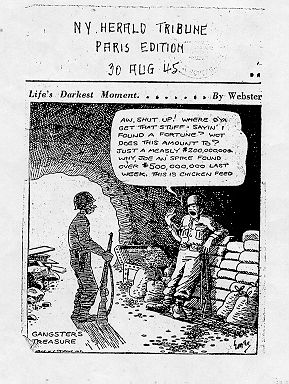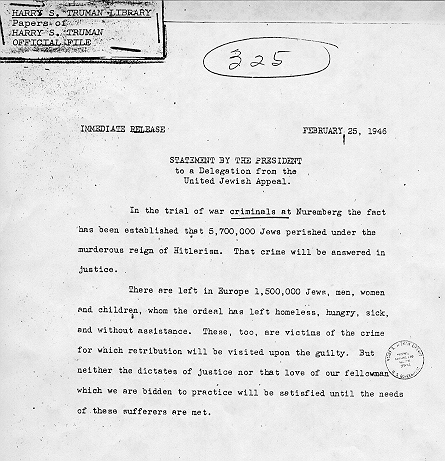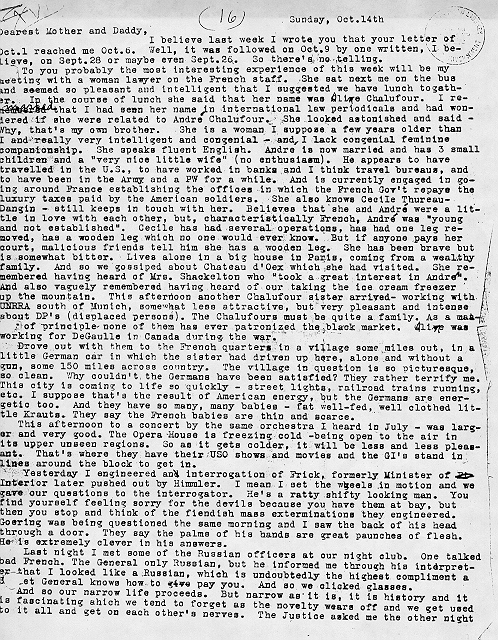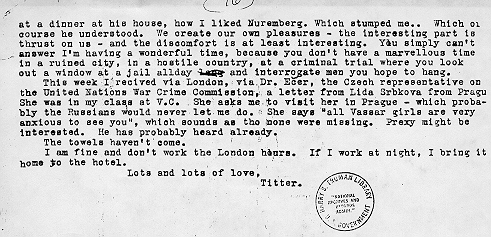Although the Nazi concentration camps were being liberated when Harry Truman inherited the presidency in April 1945, the effects of the Holocaust lasted throughout his two terms in office. The prosecution of German war criminals, the Jewish refugee crisis in Europe after the war, the reparation dilemma for victims of Nazi crimes and the creation of the Jewish state of Israel are all issues that grew out of the Holocaust.
The following documents and questions provide an introduction to the Truman administration and the Holocaust.
Students will be able to identify the long last effects of the Holocaust on the Truman administration.
Students will be able to analysis primary documents.
Missouri Standards
2. Continuity and change in the history of Missouri, the United States and the world
6. Relationships of the individual and groups to institutions and cultural traditions
7. The use of tools of social science inquiry (such as surveys, statistics, maps, documents)
Kansas Standards
Benchmark 2: The student uses a working knowledge and understanding of individuals, groups, ideas, developments, and turning points in the era of the Great Depression through World War II in United States history (1930-1945).
7. (K) examines the complexity of race and ethnic relations (e.g., Zoot Suit Riots, Japanese internment camps, American reaction to atrocities of Holocaust and unwillingness to accept Jewish refugees).
Benchmark 5: The student engages in historical thinking skills.
1. (A) analyzes a theme in United States history to explain patterns of continuity and change over time.
2. (A) develops historical questions on a specific topic in United States history and analyzes the evidence in primary source documents to speculate on the answers.
Document 1: Political Cartoon of Discovering Caves of Nazi Loot
The eastward advance of Allied troops into Germany uncovered both the horrors and the secrets of the Nazi regime. Though the most infamous of the concentration camps lay east of Berlin and were liberated by the Soviet Red Army, the Allied Forces in the west also encountered the horrors of the "final solution." But concentration camps were not the only findings of the Allied armies. Protected deep in caves from Allied bombs and shells, American and British troops discovered Nazi mines filled with confiscated valuables including rare books, priceless works art, jewelry and bars of gold. Often times, these valuables were seized from Jews prior to their deportation to concentration camps. The largest of these storage facilities was found in southcentral Germany at Merkers Mine. In this cave alone, American troops discovered 830 tons of art, jewelry and foreign currencies and 569,726 pounds of gold. The following cartoon comments on the uncovering of stored, Nazi loot.
Document Survey: Questions
- Who are the soldiers in the cartoon?
- Why is the cartoon set in a cave?
- What items have the soldiers found?
- Who does the gold most likely belong to?
- What do the words in the bottom, left corner of the cartoon imply?
- In what ways is the name of the cartoon, "Life’s Darkest Moment," appropriate?
Document 2: Press Release of President Harry Truman
Anticipating the defeat of Germany in October of 1943, the Allies established a United Nations War Crimes Commission to collect evidence that could be used to prosecute Nazi war criminals. After the surrender of Germany, President Truman appointed Supreme Court Justice Robert Jackson as chief counsel to investigate and try Nazi war criminals. From November 1945 until October 1946, the International Military Tribunal, in the former Nazi stronghold of Nuremburg, heard cases against 22 senior, Nazi leaders. The court sentenced twelve to death and three to life sentences. Hundreds of other lesser figures in the Nazi conspiracy (what Truman called "second stringers") were tried from January 1946 to April 1949. The Office of Military Government found 185 more Nazis guilty of war crimes.
Document-Survey: Questions
- Who made this statement?
- Who was this statement made to?
- When was this statement made and how does it fit into the chronology of the Nuremburg Trials?
- What is the tone of the statement?
- Can one judge Truman’s emotions by this statement?
Document 3: Personal Letter of Kathrine Fite Lincoln
Katherine Fite Lincoln was an assistant to Justice Robert Jackson in the Office of the United States Chief of Counsel for the Prosecution of Axis Criminality for the last six months of 1945. As part of the prosecution at Nuremburg, Lincoln was instrumental in constructing the case against Nazi war criminals. In the letters she wrote home to her parents, Lincoln revealed her views of the trials, the war criminals and Germany itself. The following letter illustrates both these views and the value of a personal letter to the historian.
Document-Survey: Questions
- Who is the letter written to and when was it written?
- What is the letter about? Or does it change content and tone too often to be characterized?
- What is the author’s view of Frick, Himmler and other Nazi leaders?
- How would you characterize the author’s attitudes toward Germans? How is the word "Krauts" used? Why might the author feel this way?
- Why is being "alone and without a gun" mentioned? Why might a gun be necessary?
- Why was the author stumped when asked if she was enjoying Nuremburg?
Follow-up Questions for Document One
- The discovery of mines and caves filled with valuables confiscated by the Nazis is far from a funny matter. Yet cartoons typically make light of the subjects that they concern. In what ways, if any, is this cartoon funny? Discuss the pros and cons of using humor to approach issues as sensitive and serious as war crimes.
- Reparations to victims of the Holocaust is still unresolved. Victims seeking repayment of their confiscated assets from banks that dealt with the Nazis prompted President Clinton to launch a State Department inquiry into the disposition of holdings looted by Nazi Germany during World War II. This report revealed that only a small fraction of the estimated 5.6 billion dollars seized during the war was returned. Visit the National Archives and Records Administration (NARA) Holocaust web-site to learn more about this critical issue. What course of policy has been pursued by the United States, Switzerland and many other nations to return seized assets to their pre-war holders? What else, in your opinion, should be done?
- Have you ever had another person forcibly take your possessions and not return them? What were your feelings? What actions, if any, did you take? Relate such an experience to the war reparations dilemma.
Follow-up Questions for Document Two
- The last paragraph of the press release mentions the refugees that survived the Holocaust. Nearly all of the Jews who remained after the war years were left with no home in Europe. Zionism, or the Jewish belief in returning to their homeland in Palestine, inspired many of these displaced persons to seek refuge in the Middle East. Does this document shed any light on the Truman administration’s attitude to the creation of the state of Israel? If so, under what circumstances was this future policy pursued. Visit the Harry Truman Library Student Research File regarding the recognition of Israel to learn more about this topic.
- Press secretaries are vital parts of every president’s administration. The preceding document was a public statement of President Truman. Assume the role of a press secretary and write a press release for the President concerning the discovery of Merker's Mine (see Document 1).
Follow-up Questions for Document Three
- One challenge in using personal letters as historical sources is distinguishing between fact and opinion. This letter is certainly no exception. As a group activity, reread Lincoln’s letter and underline what is a fact and circle what is an opinion. Next, draw up a list of advantages and disadvantages of this document as a piece of historical evidence. Each group should then present their list to the class and explain their choices.
- This is one of the many letters Katherine Fite Lincoln wrote to her parents while she was in Europe. How might writing to her parents determine what she wrote? How would the letter be different if it was addressed to her boss or a group of high school students? Write a 200 word summation of the letter if it were to appear as a guest column in a major newspaper.



